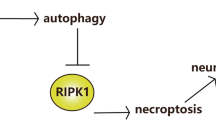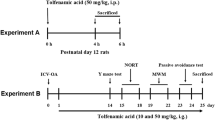Abstract
To explore the effect of glycogen synthase kinase 3β (GSK-3β) silencing on Tau-5 phosphorylation in mice suffering Alzheimer disease (AD). GSK-3β was firstly silenced in human neuroblastoma SH-SY5Y cells using special lentivirus (LV) and the content of Tau (A-12), p-Tau (Ser396) and p-Tau (PHF-6) proteins. GSK-3β was also silenced in APP/PS1 mouse model of AD mice, which were divided into three groups (n = 10): AD, vehicle, and LV group. Ten C57 mice were used as control. The memory ability of mice was tested by square water maze, and the morphological changes of hippocampus and neuron death were analyzed by haematoxylin–eosin staining. Moreover, the levels of Tau and phosphorylated Tau (p-Tau) were detected by western blotting and immunohistochemistry, respectively. The lentivirus-mediated GSK-3β silencing system was successfully developed and silencing GSK-3β at the cellular level reduced Tau phosphorylation obviously. Moreover, GSK-3β silence significantly improved the memory ability of AD mice in LV group compared with AD group (P < 0.05) according to the latency periods and error numbers. As for the hippocampus morphology and neuron death, no significant change was observed between LV group and normal control. Immunohistochemical detection and western blotting revealed that the levels of Tau and p-Tau were significantly down-regulated after GSK-3β silence. Silencing GSK-3β may have a positive effect on inhibiting the pathologic progression of AD through down-regulating the level of p-Tau.







Similar content being viewed by others
References
Reitz C, Brayne C, Mayeux R (2011) Epidemiology of Alzheimer disease. Nat Rev Neurol 7:137–152
Alzheimer’s Association (2011) 2011 Alzheimer’s disease facts and figures. Alzheimer’s Dement J Alzheimer’s Assoc 7:208
Reitz C, Mayeux R (2014) Alzheimer disease: epidemiology, diagnostic criteria, risk factors and biomarkers. Biochem Pharmacol 88:640–651
Teller J, Russo C, Debusk LM, Angelini G, Zaccheo D, Dagna-Bricarelli F, Scartezzini P, Bertolini S, Mann D, Tabaton M (1996) Presence of soluble amyloid b-peptide precedes amyloid plaque formation in Down’s syndrome. Nat Med 2:93–95
Stern D (1995) Non-enzymatically glycated tau in Alzheimer’s disease induces neuronal oxidant stress resulting in cytokine gene expression and release of amyloid b-peptide. Nat Med 1:693–699
Delacourte A, Defossez A (1986) Alzheimer’s disease: tau proteins, the promoting factors of microtubule assembly, are major components of paired helical filaments. J Neurol Sci 76:173–186
Ittner LM, Götz J (2011) Amyloid-β and tau—a toxic pas de deux in Alzheimer’s disease. Nat Rev Neurosci 12:67–72
Israel MA, Yuan SH, Bardy C, Reyna SM, Mu Y, Herrera C, Hefferan MP, Van Gorp S, Nazor KL, Boscolo FS (2012) Probing sporadic and familial Alzheimer’s disease using induced pluripotent stem cells. Nature 482:216–220
DaRocha-Souto B, Coma M, Perez-Nievas B, Scotton T, Siao M, Sánchez-Ferrer P, Hashimoto T, Fan Z, Hudry E, Barroeta I (2012) Activation of glycogen synthase kinase-3 beta mediates β-amyloid induced neuritic damage in Alzheimer’s disease. Neurobiol Dis 45:425–437
Hernández F, Borrell J, Guaza C, Avila J, Lucas JJ (2002) Spatial learning deficit in transgenic mice that conditionally over-express GSK-3β in the brain but do not form tau filaments. J Neurochem 83:1529–1533
Lewis J, Dickson DW, Lin W-L, Chisholm L, Corral A, Jones G, Yen S-H, Sahara N, Skipper L, Yager D (2001) Enhanced neurofibrillary degeneration in transgenic mice expressing mutant tau and APP. Science 293:1487–1491
Leroy K, Yilmaz Z, Brion JP (2007) Increased level of active GSK-3β in Alzheimer’s disease and accumulation in argyrophilic grains and in neurones at different stages of neurofibrillary degeneration. Neuropathol Appl Neurobiol 33:43–55
Sutherland C, Leighton IA, Cohen P (1993) Inactivation of glycogen synthase kinase-3 beta by phosphorylation: new kinase connections in insulin and growth-factor signalling. Biochem J 296:15–19
Jin N, Yin X, Yu D, Cao M, Gong C-X, Iqbal K, Ding F, Gu X, Liu, F (2015) Truncation and activation of GSK-3β by calpain I: a molecular mechanism links to tau hyperphosphorylation in Alzheimer’s disease. Sci Rep 5:8187
Barilar JO, Knezovic A, Grünblatt E, Riederer P, Salkovic-Petrisic M (2015) Nine-month follow-up of the insulin receptor signalling cascade in the brain of streptozotocin rat model of sporadic Alzheimer’s disease. J Neural Transm 122:565–576
Kohnken R, Buerger K, Zinkowski R, Miller C, Kerkman D, DeBernardis J, Shen J, Möller H-J, Davies P, Hampel H (2000) Detection of tau phosphorylated at threonine 231 in cerebrospinal fluid of Alzheimer’s disease patients. Neurosci Lett 287:187–190
Vanmechelen E, Vanderstichele H, Davidsson P, Van Kerschaver E, Van Der Perre B, Sjögren M, Andreasen N, Blennow K (2000) Quantification of tau phosphorylated at threonine 181 in human cerebrospinal fluid: a sandwich ELISA with a synthetic phosphopeptide for standardization. Neurosci Lett 285:49–52
Itoh N, Arai H, Urakami K, Ishiguro K, Ohno H, Hampel H, Buerger K, Wiltfang J, Otto M, Kretzschmar H (2001) Large-scale, multicenter study of cerebrospinal fluid tau protein phosphorylated at serine 199 for the antemortem diagnosis of Alzheimer’s disease. Ann Neurol 50:150–156
Llorens-Marítin M, Jurado J, Hernández F, Ávila J (2014) GSK-3β, a pivotal kinase in Alzheimer disease. Front Mol Neurosci 7:46
Mandelkow E-M, Mandelkow E (2012) Biochemistry and cell biology of tau protein in neurofibrillary degeneration. Cold Spring Harb Perspect Med 2:a006247
Doble BW, Woodgett JR (2007) Role of glycogen synthase kinase-3 in cell fate and epithelial-mesenchymal transitions. Cells Tissues Organs 185:73–84
Terwel D, Muyllaert D, Dewachter I, Borghgraef P, Croes S, Devijver H, Van Leuven F (2008) Amyloid activates GSK-3β to aggravate neuronal tauopathy in bigenic mice. Am J Pathol 172:786–798
Zheng W-H, Bastianetto S, Mennicken F, Ma W, Kar S (2002) Amyloid β peptide induces tau phosphorylation and loss of cholinergic neurons in rat primary septal cultures. Neuroscience 115:201–211
Deng Y, Xiong Z, Chen P, Wei J, Chen S, Yan Z (2014) β-Amyloid impairs the regulation of N-methyl-D-aspartate receptors by glycogen synthase kinase 3. Neurobiol Aging 35:449–459
Koh S-H, Noh MY, Kim SH (2008) Amyloid-beta-induced neurotoxicity is reduced by inhibition of glycogen synthase kinase-3. Brain Res 1188:254–262
Magdesian MH, Carvalho MM, Mendes FA, Saraiva LM, Juliano MA, Juliano L, Garcia-Abreu J, Ferreira ST (2008) Amyloid-β binds to the extracellular cysteine-rich domain of Frizzled and inhibits Wnt/β-catenin signaling. J Biol Chem 283:9359–9368
Christian SL, Sims PV, Gold MR (2002) The B cell antigen receptor regulates the transcriptional activator β-catenin via protein kinase C-mediated inhibition of glycogen synthase kinase-3. J Immunol 169:758–769
Lucas JJ, Hernández F, Gómez-Ramos P, Morán MA, Hen R, Avila J (2001) Decreased nuclear β-catenin, tau hyperphosphorylation and neurodegeneration in GSK-3β conditional transgenic mice. EMBO J 20:27–39
Engel T, Hernández F, Avila J, Lucas JJ (2006) Full reversal of Alzheimer’s disease-like phenotype in a mouse model with conditional overexpression of glycogen synthase kinase-3. J neurosci 26:5083–5090
Roberson ED, Scearce-Levie K, Palop JJ, Yan F, Cheng IH, Wu T, Gerstein H, Yu G-Q, Mucke L (2007) Reducing endogenous tau ameliorates amyloid ß-induced deficits in an Alzheimer’s disease mouse model. Science 316:750–754
Augustinack JC, Schneider A, Mandelkow E-M, Hyman BT (2002) Specific tau phosphorylation sites correlate with severity of neuronal cytopathology in Alzheimer’s disease. Acta Neuropathol (Berl) 103:26–35
Luna-Munoz J, Chavez-Macias L, Garcia-Sierra F, Mena R (2007) Earliest stages of tau conformational changes are related to the appearance of a sequence of specific phospho-dependent tau epitopes in Alzheimer’s disease. J Alzheimer’s Dis 12:365–375
Sengupta A, Kabat J, Novak M, Wu Q, Grundke-Iqbal I, Iqbal K (1998) Phosphorylation of tau at both Thr 231 and Ser 262 is required for maximal inhibition of its binding to microtubules. Arch Biochem Biophys 357:299–309
Li T, Hawkes C, Qureshi HY, Kar S, Paudel HK (2006) Cyclin-dependent protein kinase 5 primes microtubule-associated protein tau site-specifically for glycogen synthase kinase 3β. Biochemisty 45:3134–3145
de Barreda EG, Pérez M, Ramos PG, de Cristobal J, Martín-Maestro P, Morán A, Dawson HN, Vitek MP, Lucas JJ, Hernández F (2010) Tau-knockout mice show reduced GSK3-induced hippocampal degeneration and learning deficits. Neurobiol Dis 37:622–629
Hernández F, de Barreda EG, Fuster-Matanzo A, Lucas JJ, Avila J (2010) GSK3: a possible link between beta amyloid peptide and tau protein. Exp Neurol 223:322–325
Li Y-P, Yang G-J, Jin L, Yang H-M, Chen J, Chai G-S, Wang L (2015) Erythropoietin attenuates Alzheimer-like memory impairments and pathological changes induced by amyloid β 42 in mice. Brain Res 1618:159–167
Xie M, Shi R, Pan Y, Zeng T, Chen Q, Wang S, Liao X (2014) Proteasome inhibition-induced downregulation of Akt/GSK-3β pathway contributes to abnormality of tau in hippocampal slice. Mol Neurobiol 50:888–895
Acknowledgments
This research was supported by National Natural Science Foundation of China (30970989) and Science and Technology Development Program of Jinan City (201401075).
Author information
Authors and Affiliations
Corresponding author
Ethics declarations
Conflict of interest
None declared.
Rights and permissions
About this article
Cite this article
Bian, H., Bian, W., Lin, X. et al. RNA Interference Silencing of Glycogen Synthase Kinase 3β Inhibites Tau Phosphorylation in Mice with Alzheimer Disease. Neurochem Res 41, 2470–2480 (2016). https://doi.org/10.1007/s11064-016-1960-7
Received:
Revised:
Accepted:
Published:
Issue Date:
DOI: https://doi.org/10.1007/s11064-016-1960-7




